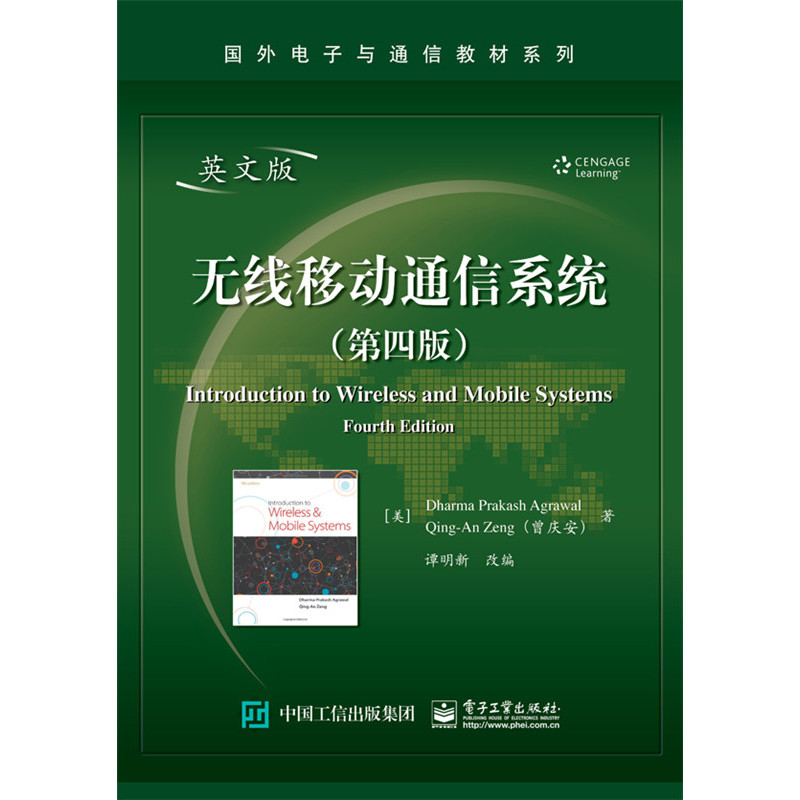
无线移动通信系统-(第四版)-英文版

温馨提示:5折以下图书主要为出版社尾货,大部分为全新(有塑封/无塑封),个别图书品相8-9成新、切口有划线标记、光盘等附件不全详细品相说明>>
- ISBN:9787121285134
- 装帧:暂无
- 册数:暂无
- 重量:暂无
- 开本:16开
- 页数:422
- 出版时间:2016-04-01
- 条形码:9787121285134 ; 978-7-121-28513-4
本书特色
本书系统、全面地介绍了无线移动通信的基本理论,分析了无线移动通信所涉及的各个主题,包括无线移动信号的传输、蜂窝的基本概念、多路无线接入、多址技术、调制技术、信道分配技术、通信系统的设计、网络协议、现有的蜂窝系统、ieee 802系列技术、ad hoc网络与传感器网络、无线网络的安全性与隐私问题、卫星通信系统等。为了加强对书中概念的理解,各章还给出了开拓思维的实验。
内容简介
本书覆盖了无线移动通信所涉及的各个主题,还提供了开拓思维的实验项目,是无线移动通信本科课程的理想双语教材。
目录
作者简介
Dharma Prakash Agrawal 博士,美国俄亥俄州教育局计算机科学与工程专业杰出教授,美国辛辛那提大学电气工程与计算机科学系分布式移动计算中心的创办主任。他获得了IEEE计算机学会的众多证书和奖励,并被选为核心成员,他还是ACM、AAAS和WIF会士,美国国家发明家科学院的资深会员,2008年获得哈里谷德奖(IEEE CS Harry Goode Award)。Qing-An Zeng(曾庆安) 1997年于日本静岗大学获得电子工程学博士学位,毕业后进入日本电气株式会社(NEC),从事第三代移动通信系统的开发和研究,曾作为NEC的两名专家代表之一参加了第三代移动通信系统的数据层和网络层的标准制定工作,还作为NEC的专家代表参加了香港第三代移动通信系统的选定工作。1999年,他被美国辛辛那提大学聘为教授、博士生导师。他还是IEEE高级会员。
-

落洼物语
¥8.7¥28.0 -

当代中国政府与政治(新编21世纪公共管理系列教材)
¥33.6¥48.0 -

中国当代文学名篇选读
¥19.1¥53.0 -

中医基础理论
¥50.7¥59.0 -

北大人文课(平装)
¥13.9¥45.0 -

外国教育史-第2版
¥24.4¥40.0 -

宪法-第二版
¥12.2¥29.0 -

先进防伪技术
¥81.3¥98.0 -

当代中国政府与政治 第二版
¥57.8¥68.0 -

EPLAN电气设计
¥29.9¥39.8 -

闯进数学世界――探秘历史名题
¥21.3¥32.8 -

企业法务教程
¥34.8¥49.0 -

习近平新时代中国特色社会主义思想概论
¥18.2¥26.0 -

毛泽东思想和中国特色社会主义理论体系概论(2021年版)
¥6.8¥25.0 -

金融学
¥29.9¥49.0 -

计算机操作系统教程(第4版)(清华大学计算机系列教材)
¥31.9¥49.0 -

古代汉语(第四册)
¥16.1¥35.0 -

管理学:原理与方法(第7版)(博学.大学管理类)/周三多
¥30.9¥49.0 -

(平装)北大必修课:北大口才课
¥12.2¥45.0 -

海商法-第四版
¥30.2¥48.0











